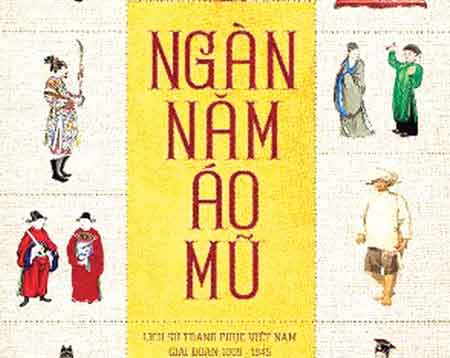VietNamNet Bridge – An expansive new book tracking the attire worn by Vietnamese people from all levels of society throughout the last 1,000 years was released on Thursday to critical fanfare.

|
|
Descriptive: The book cover illustration depicts attire worn by Vietnamese people from all levels of society. |
Many experts have been quick to describe the book, titled Ngan Nam Ao Mu (A Study of Costumes in 1,000 Years), as the most comprehensive research ever undertaken on the subject.
Through texts and images, the book provides a very detailed description of how Vietnamese people from the Ly dynasty, Nguyen dynasty and beyond dressed.
Its author, Tran Quang Duc, a 28-year-old researcher from the Viet Nam Institute of Literature, has spent many years searching the country and abroad for historical evidence of the costumes worn by people from different regions, social backgrounds and historical periods.
Over the past, experts have criticised Vietnamese historical films for featuring incongruous costumes either from a different time period or overly influenced by the costume designs of Chinese films. It was this contention that made Duc realise the lack of knowledge about Vietnamese dress and the fashion styles of the ancestors.
"I really felt that there was a place for some meticulous research on the subject. I noticed that people don't just argue about what people wore, but also about the extent of the influence. I wanted to find some definitive answers," he said.
He was happy to find through his research that despite the influence of Chinese attire as a standard to follow, Vietnamese clothes and hair styles had their own strong identity.
"While kings of other countries influenced by Chinese culture expressed humbleness by wearing less extravagant costumes, Vietnamese kings always wore similar attire to Chinese kings," said Duc.
"For example, a Chinese king's crown had 12 tassels and 12 gems and so did the Vietnamese kings'. Meanwhile Korean kings wore a crown with nine tassels like Chinese's princes and high ranking mandarins. From this level of equality, Viet Nam began to express its individuality more."
While royal costumes changed through different reigns, the clothes worn by the common people remained simple and unchanged until 1744 when Lord Nguyen Phuc Khoat issued a decree to revamp the clothing styles favoured by both the royal family and his subjects. People had to change from their simple cloth outfits to a five-flapped dress.
Researcher Trinh Bach, who has spent many years studying traditional culture, especially Vietnamese royal costumes, is one of many experts to praise the new book. He said it would be a valuable reference for historians and anyone with an interest in its fascinating subject matter.
Bach said other historical books like Dai Viet Su Ky Toan Thu (The Complete Annals of Dai Viet) and Dai Nam Thuc Luc Chinh Bien (A True Record of Great Viet Nam) were important and reliable sources, but the information about Vietnamese clothing was very little.
"Through the cursory descriptions in these books and the lack of illustrations, it is difficult to imagine what people wore in the past," he said.
"Meanwhile, films, which are the most effective means to popularise culture and history, do not present audiences with accurate knowledge of old costumes because they have no real reference point. I'm anxious that without more research like Duc's, future generations will have no idea about their ancestors' attire."
Duc, along with experts in the field, will organise a seminar in September at L'Espace in Ha Noi, to discuss the book and exchange information with readers.
Ngan Nam Ao Mu, published by the Nha Nam Company and The Gioi (World) publishing house, is being sold at VND250,000 (US$12).
Source: VNS